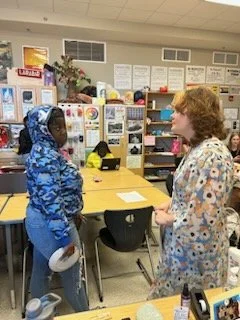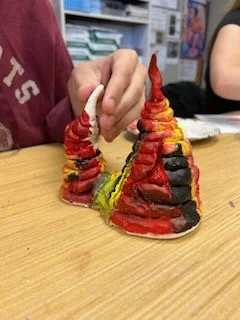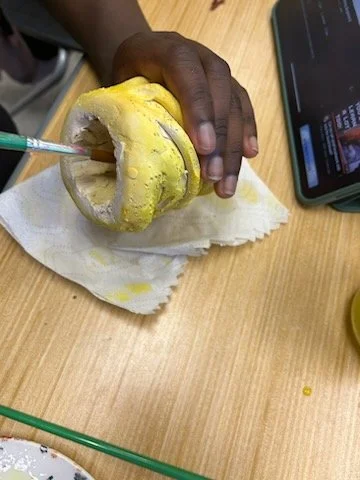Secondary Education Student Teaching Overview
I spent my secondary education student teaching at Clarke Central High School, learning under the photography and sculpture teacher Amanda Price. Under the guidance of my mentor teacher, I took over her Sculpture I. class, an introductory art class which focused on the cumulative methods of creating 3-D art within the art classroom. I had the chance to observe additive and subtractive methods of sculpture, and design a unit plan around several contemporary ceramic sculptors. I also had the opportunity to assist with Sculpture II and Photography II, and gain teaching experience in Photography. The lesson plan I created involved the work of artists like Eusebio Sanchez, Huey Hyuk Lee, Yeesookyung, Rebecca Appleby, Donté K. Hayes, and Renquian Yang.
Finding Creative Solutions to Engagement in the Secondary Classroom
The main thing that I noticed in my time student teaching within Clarke Central High School is students lacking engagement. Many high school students at Clarke Central preferred to look at their phones than pay attention to lessons, and as a result sometimes I felt like the room was lacking engagement. With the guidance of Amanda Price, I learned more about engaging high school students. Although stating expectations and routine is not as emphasized as it was in elementary school, high school students still required a sense of engagement and routine. as a result, we always started the day with an artist talk, discussing a contemporary or historical artist who has themes relating to what lesson we were learning that day. The artist talk leads into the lesson, or an explanation of what students need to accomplish. After the lesson, students begin their activity and work on their art projects. As a student teacher, I found it was a good idea to talk to each student about their progress and connect with them about their work; through this casual interaction, relationships could be formed with the students and they understood that those teaching cared about their progress and accomplishment.
Working with Sculpture I students as they learned about ceramic sculpture.
Differentiation within the high school art classroom is an important step of lesson planning. Students came into Sculpture I with a very mixed bag of skills; while some students were regarded as accomplished artists among their peers, some lacked confidence regarding their artistic knowledge and skill level. Part of my job as a student teacher was to build my students up, as well as give them the knowledge and ideas that they lacked within the art room. Through finding ways to check in with students and consistently scaffold their ideas, students gained competency in their technical skill levels. Making lesson prompts broad but structured allowed students to operate with a sense of freedom and find ways to foster their own skill levels. In the way that I applied differentiation strategies in teaching Sculpture I to Clarke Central High School students, I fulfilled InTASC Standard 7, in which I was able to support every student by using classroom context to scaffold individual learning growth.
With the help of Amanda Price, I was also able to consider InTASC Standard 9, which focused on the process of reflection. Through spending time in the high school classroom, I was able to grow in my own skills and be mentored, which resulted in continual self-reflection. Using the self-reflection I was encouraged to engage in, I was able to meet the learning needs with each student in my classroom.
UNIT PLAN PROJECT
I was asked to create a unit plan that addressed the need for the Sculpture I students to learn about ceramics. I found contemporary ceramics artists which worked abstractly, and I developed my unit to focus on emotional intelligence. Students were asked to create a 3-D abstract ceramic sculpture which focused on being a “vessel” that could house an emotion. Throughout the course of the lesson, ceramic safety considerations were heavily talked about, especially the dangers of clay dust and not cleaning tools. We discussed how using pinch pots and coil building are critical ways that both historical and contemporary ceramic artists work with clay, and talked about how the students should use these processes within their own work.
Because Sculpture I, II, and III are popular courses within Clarke Central High School, I was designing the ceramic sculptural unit for both myself and the other sculpture teacher, Heather Garland. Together, we worked collaboratively to figure out a pace and a focus for the unit. In this way, InTASC Standard 10 became a big part of my teaching practice within my time at Clarke Central. Every Friday I met up with the other art teachers and planned what the following week would look like in terms of student progress.
moving into the future
Moving into the future, I learned that the primary focus of my secondary education is finding ways to motivate students, while also thinking about a broad lesson plan and curriculum which thinks about differentiation. I also learned that building a sense of communication and community within the classroom is absolutely crucial. Being the sort of teacher who takes the time to learn about what each student needs while teaching shows learners respect, and care. While I want my classroom to be a place where students learn new skills, I want my classroom also to be a place where students feel comfortable, cared for, and respected.




